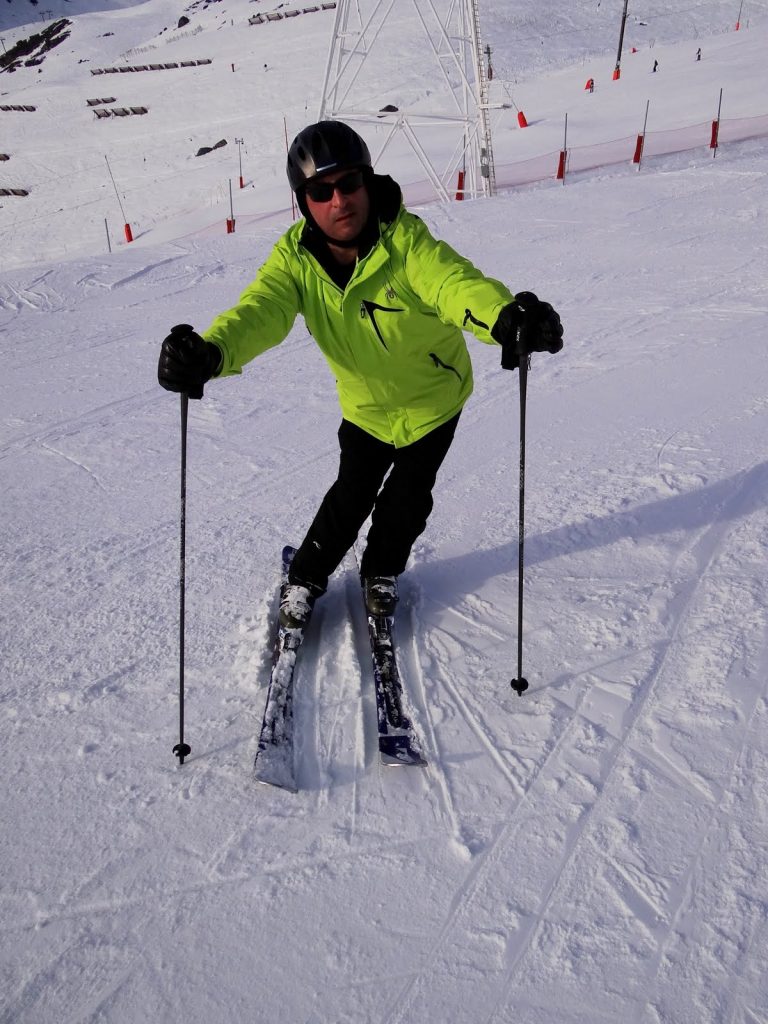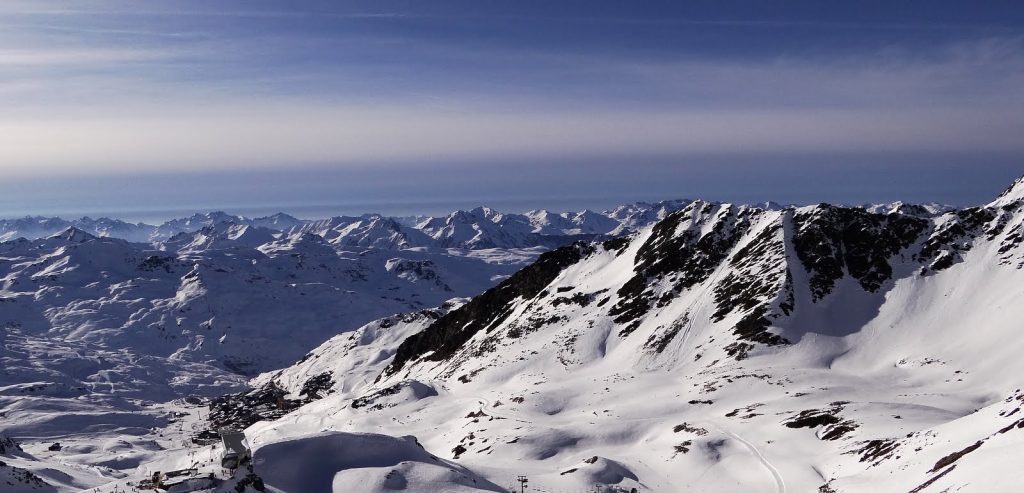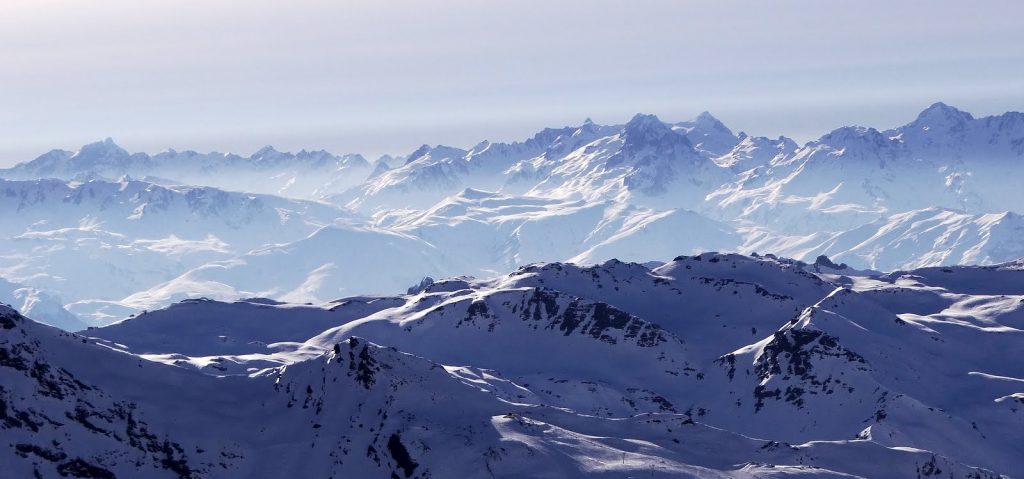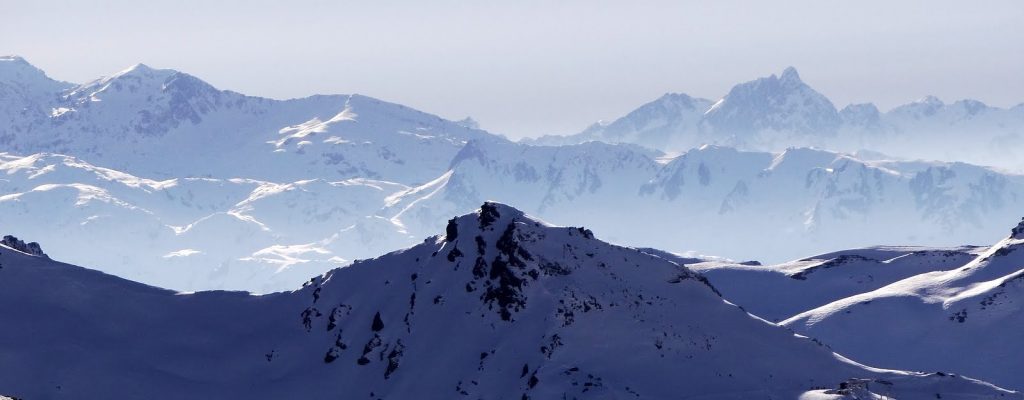Val Thorens – views from above 3000m
Leo
Leo was clearly struggling with his skiing so first thing in the morning he was the main priority. Unfortunately he had already had a full week of instruction with Hunt several years earlier and this hadn’t worked. He was still an ineffective snowplough skier fighting a physical battle on every turn. Close to the end of my working relationship with Hunt it had become clear that he had never understood the differences in our teaching methods – despite many hours of discussing the issues. This underlines the powerful way in which people can unintentionally delude themselves. Eventually I stopped discussing ski technique with most professionals because they all insist that they are teaching the same way and that they know what you are talking about – even when they are completely ignorant of the issues. Only rarely do you stumble upon the exception to this rule.
Coordination and Edge use
The first thing I did with Leo was to look at pivoting. This was intended to make him aware that there was an alternative coordination to “pushing out” into a snowplough and that is was the opposite – “pulling in” with the adductor muscles. We did a couple of exercises to make clear which muscles we were discussing and what it feels like to “pull inwards”. The action means that the turn starts from the uphill edge of the top ski – so this is a major change – perhaps too difficult for someone with a strong habit of looking for security in the plough shape on the downhill edge of the top ski. I assisted everyone through a pivoted turn with physical support. We should have practised more using the ski pole for support but there wasn’t time to go into too much depth.
Leo didn’t manage to overcome his impulse to seek security (false security) from the plough. The top ski acts as an accelerator when in a plough and on slightly steeper ground this simply doesn’t give control with the body weight of an adult.
Dynamics
Observing Leo it was clear that he was transferring his weight to the outside ski – “balancing” his centre of mass over the outside leg. This was obviously wearing him out because it set up a total conflict between his body and the mechanics of the turn. We did a brief session on “dynamics” – with Leo understanding the effects of accelerating his body into the turn – instead of balancing his body over his outside leg. This was enough to stop the conflict that was wearing him out and making him totally unstable. Leo began to understand that his limits were really defined through dynamics and not though “balancing”. I pointed out that the skier has one job – to fall over – and the ski has one job – to bring you back up. Everything works on this principle. Aiming for “balance” is self defeating and incorrect.
Zeno
Free Float
Zeno was following the session with Leo but had a few questions of his own. The main issue for Zeno was that he tended to be caught on the back of his ski boots – through failing to adjust to the perpendicular to the mountain. Many people remain “vertical” to gravity because they are not used to being in an acceleration state. Where accelerations exist then “vertical” is no longer appropriate – just like “balance” is no longer appropriate. I explained how we are in a state of “free float” just as in outer space and that the only feedback we have is through the feet – from the “elastic” force of the Earth stopping our floating. When we remove some of this resistance (by pointing skis downhill) and then accelerate – then part of the force under our feet disappears – in proportion to the steepness of the slope. At 90° there would be zero pressure under the foot and maximum acceleration. In any case you adjust so that your base of support is “normal” to the ground – that is – perpendicular to the mountain. The resistance force that you feel is “normal” to the slope. In practical terms this means that it feels exactly the same whether you are “vertical” going across the hill or “perpendicular” going downhill. All the sensations in the feet and against the boots should remain the same. There is no sensation of “leaning” to compensate or equally of getting caught on the back of the boots. It is best to look for a light contact of the shin constantly against the front of the boot and to feel pressure under the mid-foot to forefoot. The foot must be used “actively” in that the muscles need to work instead of becoming loose and allowing the ankle to flex. The ankle needs to lock and to be strong.
Basically for Zeno to progress he needs more sustained coaching feedback. Simply put – “miles on skis” is neither appropriate nor enough to get to another level. We end up practising just bad or mindless habits. Most “professional” ski coaching makes little difference because it is technically extremely stupid – but this should not become a reference.
Rocking Feet
Watching Zeno ski it was clear that he was not aware of his feet and this could be seen by the way his legs were functioning. Asking him directly about his feet confirmed this observation. I explained roughly about the sub taler joint below the ankle and how to rock the feet from edge to edge inside the ski boots. The basic principle is to associate the edges of the feet directly with the edges of the skis. This sparks a chain reaction in the muscles right up to the core – through the adductor muscles of the legs – which is what I was looking for from Zeno. Pert of the issue was to help Zeno become more independent in his leg use. Much of his fore-aft motion problem was coming from being “two footed” and unable to respond reflexively as a result. The rocking of the feet in the direction of the dynamics is a self reinforcing action – creating a more powerful and stable turning effect. I showed how the feet actually turn slightly counter to the turn – the opposite of what happens when somebody “pushes outwards” and twists the foot in the direction of the turn.
Double Adductors
One interesting issue that Zeno brought up was the question of what to do with the adductors on the “inside” leg that wasn’t being used in the turn. I explained that regardless of what the leg was doing the adductors need to be contracted. This can be understood when looking at the next level of pivoting skills. This level requires that the edge of the foot and edge of the ski be dissociated. You stand on the top ski and on the uphill edge, but rock the foot onto the lower inside edge inside the ski boot – without changing the ski edge. This allows you to use the adductor muscles for pivoting (along with the centre of mass moving into the turn) and with no resistance from the inside edge of the ski. The ski changes edge after passing through the fall line and then the edge of the foot and the ski line up automatically for support – all on the inside. Now, if you do the turn just standing on the lower ski instead, you still need to pull inwards with the adductor muscles to get the correct geometry with the ski against the slope while the centre of mass leans outside over the skis to be supported downhill on the ski pole. Effectively, there is always a requirement to contract the adductor muscles regardless of which ski is used – so it makes sense to always keep them active even when the inside leg is not supporting the skier during a turn. There are standard exercises (knee to boot chase) which actively encourage the opposite – to pull the inside knee in towards the turn centre (aBductors) – but I’d reserve that for specific cases where people need correction for the presence of an “A frame” stance or similar postural issues.
George
George had lost a lot of weight – which makes life very different with any athletic activity such as skiing. He was aware of how his technique was limiting his security and capacity on skis and this probably inclined him towards being over cautious to some extent. Part of the fun of skiing is discovering how your body responds when you just throw yourself into things. The body reflexively adapts very rapidly and after making an error once or twice it will find a way to circumvent that problem. I’d explained earlier on with Leo that skiing is “holistic” in that you don’t need to do any particular thing “perfectly” for the overall process to function. This allows you to progressively work on issues and improve them over time. For George the main issue to work on was hip angulation.
ChiSkiing
To introduce hip angulation correctly I explained the basics of ChiRunning and how without this understanding the inappropriate use of the hips and core muscles even in walking eventually leads to mechanical issues which prevent hip angulation in skiing. I showed how the standard idea of “countering” the body to a turn causes the spine to twist against the turn and compress the ribs against the pelvis. If only the pelvis is countered against the turn and both the foot and the shoulder maintained “forwards” then the spinal twist reverses and is in the direction of the turn – opening up the midsection and activating the core muscles. George grasped the basic mechanics quickly and was able to work on this consistently. This “countering” effect however caused him to lose his dynamics to some extent and he started to place his body slightly outwards over his outside leg against the dynamics of the turn – instead of making the pelvic adjustment smoothly as he let his body drop down into the turn. In addition he started to “break” at the waist – nodding the upper body up and down. This “nodding” was stopped by showing George how to “sit” to lower the centre of mass. I took off my skis on a steep slope and went into a seated position facing downhill. The resultant force was on the balls of my feet due to the geometry of the hill. George could see that lowering the centre of mass into a turn was more of an effort to “sit” than to “nod” the upper body.
Upper Lower Body Separation
I also explained that the upper/lower body separation was now not to be viewed as being in the hip joints – but progressively spread from the hip joints right up to the 12th vertebra and the rib cage.
Jack
The only reason I was in Val Thorens for the day was due to Jack’s insistence on doing something useful with his time – against he relatively aimless backdrop of his friends. Jack is a much stronger skier than the others – and that is no accident. Jack is aware that what you get out of something accurately reflects your input – and that is most critical in an activity where skill and perception is involved. Perhaps this comes from his active interest in racing cars.
 Jack’s angulation was his man limiting factor at this stage so he shared the same lesson as George. George had been more successful in applying the pelvic counter-rotation but that was due to Jack having a much stronger “survival” process in place already that he could rely on to get through challenging terrain. In the photo here Jack was able to isolate and counter rotate the pelvis – pulling the hip back on his right side. The moment he started to ski this would completely disappear as is seen in the video above. Jack was concerned that this stance looked a bit “gay” – with the bum being stuck out to one side. I guess that’s right – but in action it wouldn’t look exactly like this so that’s not a real worry! Jack actually had “negative” angulation when skiing – with his bum sometimes sticking outwards during the turn – which really does look gay! The image on the front of the video clip above shows this curvature slightly in the “wrong” direction – outwards instead of inwards. In reality this isn’t an issue at the start of a turn as seen above – but is a problem if it is still like this when the forces build up towards the end of a turn. Jack was compensating for lack of angulation by frequently standing on his inside ski.
Jack’s angulation was his man limiting factor at this stage so he shared the same lesson as George. George had been more successful in applying the pelvic counter-rotation but that was due to Jack having a much stronger “survival” process in place already that he could rely on to get through challenging terrain. In the photo here Jack was able to isolate and counter rotate the pelvis – pulling the hip back on his right side. The moment he started to ski this would completely disappear as is seen in the video above. Jack was concerned that this stance looked a bit “gay” – with the bum being stuck out to one side. I guess that’s right – but in action it wouldn’t look exactly like this so that’s not a real worry! Jack actually had “negative” angulation when skiing – with his bum sometimes sticking outwards during the turn – which really does look gay! The image on the front of the video clip above shows this curvature slightly in the “wrong” direction – outwards instead of inwards. In reality this isn’t an issue at the start of a turn as seen above – but is a problem if it is still like this when the forces build up towards the end of a turn. Jack was compensating for lack of angulation by frequently standing on his inside ski.
Hockey Stops
We worked on steeper ground using bumps to assist the pivot of the skis and a strong use of pole support to allow the centre of mass to get downhill without the skis changing edge at the start of the turn. To encourage direct fall-line skiing and angulation at the end of the turns we did individual hockey stops on steep ground. I explained that the pivot was for entering a turn from a sideslip – or at most a forward diagonal sideslip. It is a “braking” form of skiing. When you travel across the hill then you pick up speed and then revert to “inside edge” skiing with bigger dynamics involved. To ski with the feet moving directly downhill in short slow turns you need to use the pivot (always on uphill edges) and you need good support from the ski poles and good control of angulation both to complete a turn and to get the upper-body over the ski pole and into the next turn.
Steeps
When George eventually bailed out, pretending to have pulled a muscle, we went off piste onto some more interesting steep ground. Jack immediately reverted to an upper ski stem turn and up-unweighting to survive his turns. I explained that he had to discipline himself to use what we had been practising and to use the centre of mass moving downwards to initiate his turns from a pivot – pulling inwards instead of stepping outwards from a platform. The up-unweighting has drastic consequences on the steep because you come back down with a lot of force. Jack was compensating by using his dynamics to get on his inside ski for protection. This works but it’s a poor substitute for good technique. This is where angulation comes into it’s own. You get “inside” by angulating as well as using dynamics and this keeps you lower and smoother through the turn so there is no sudden over-loading of pressure in the unpredictable wind packed snow. This way you can stay solidly on the outside ski through the turn and then use it to predictably bring yourself back up and out of the turn – committing clearly to the next one.
Pressure Cycle
I explained to Jack that he should use a lower “seated stance” as we had looked at for George earlier. This keeps the knees and feet ahead on the tricky snow. In addition is is important to aim for the maximum pressure on the turn to be towards the side and not down below. This avoids the pressure from gravity and momentum from combining at the same moment and becoming overwhelming in tricky snow. The same principle allows for control of direction and maintenance of speed in slalom racing.
Mindful Skiing
Jack is the only one in the group who is really switched on to understanding that personal development is a never ending process – one that takes place regardless of your intentions. If you are not mindfully working on improvement then your “development” heads off directly against your best interests. Your form deteriorates. This applies to everything. You use it or you lose it.
Each aspect of skiing that we worked on – the spinal twist, the feet rocking, the use of pole support, etc. – is a “form focus”. Your skiing is holistic so it functions in general anyway, but this permits you to focus on specific aspects of form and to integrate new movements through training. Focusing your attention on an aspect of form is in turn a mental exercise. The focus will drift after a minute or two but it’s important to return back to the focus when you realise that your mind has wandered. This process of focusing and refocusing trains the mind – but ironically it also relaxes the mind. Relaxation comes because all the external chatter is suppressed and all of the worries from negative internal dialogue disappear. Sensing movements and position with your body train you to have a better connection between the body and mind – this grounds you better as a person – reinforces your own identity and brings you back in touch with yourself. This process strengthens as your mechanics of movement improve and your self awareness grows.
George tried to point out that some people just want to come out to ski and relax – to potter about and stay at a certain level. That’s true, they do. I’m sorry for them and their eternal dissatisfaction.






